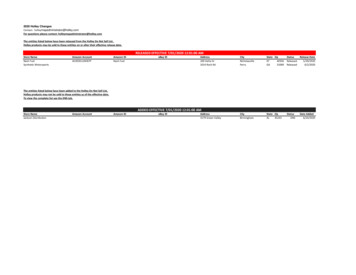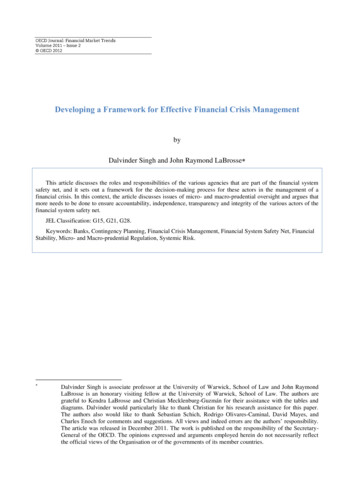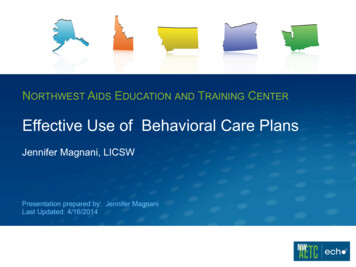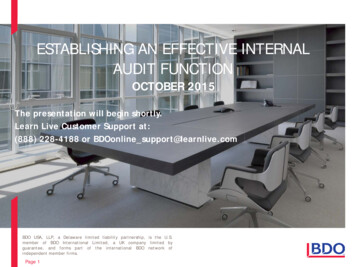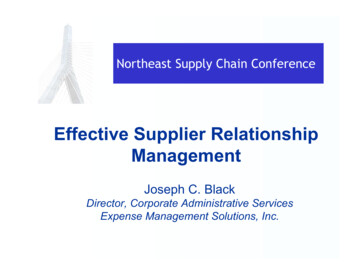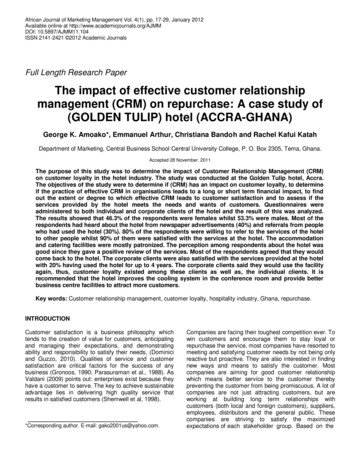
Transcription
African Journal of Marketing Management Vol. 4(1), pp. 17-29, January 2012Available online at http://www.academicjournals.org/AJMMDOI: 10.5897/AJMM11.104ISSN 2141-2421 2012 Academic JournalsFull Length Research PaperThe impact of effective customer relationshipmanagement (CRM) on repurchase: A case study of(GOLDEN TULIP) hotel (ACCRA-GHANA)George K. Amoako*, Emmanuel Arthur, Christiana Bandoh and Rachel Kafui KatahDepartment of Marketing, Central Business School Central University College, P. O. Box 2305, Tema, Ghana.Accepted 28 November, 2011The purpose of this study was to determine the impact of Customer Relationship Management (CRM)on customer loyalty in the hotel industry. The study was conducted at the Golden Tulip hotel, Accra.The objectives of the study were to determine if (CRM) has an impact on customer loyalty, to determineif the practice of effective CRM in organisations leads to a long or short term financial impact, to findout the extent or degree to which effective CRM leads to customer satisfaction and to assess if theservices provided by the hotel meets the needs and wants of customers. Questionnaires wereadministered to both individual and corporate clients of the hotel and the result of this was analyzed.The results showed that 46.3% of the respondents were females whilst 53.3% were males. Most of therespondents had heard about the hotel from newspaper advertisements (40%) and referrals from peoplewho had used the hotel (30%). 80% of the respondents were willing to refer to the services of the hotelto other people whilst 90% of them were satisfied with the services at the hotel. The accommodationand catering facilities were mostly patronized. The perception among respondents about the hotel wasgood since they gave a positive review of the services. Most of the respondents agreed that they wouldcome back to the hotel. The corporate clients were also satisfied with the services provided at the hotelwith 20% having used the hotel for up to 4 years. The corporate clients said they would use the facilityagain, thus, customer loyalty existed among these clients as well as, the individual clients. It isrecommended that the hotel improves the cooling system in the conference room and provide betterbusiness centre facilities to attract more customers.Key words: Customer relationship management, customer loyalty, hospitality industry, Ghana, repurchase.INTRODUCTIONCustomer satisfaction is a business philosophy whichtends to the creation of value for customers, anticipatingand managing their expectations, and demonstratingability and responsibility to satisfy their needs, (Dominiciand Guzzo, 2010). Qualities of service and customersatisfaction are critical factors for the success of anybusiness (Gronoos, 1990; Parasuraman et al., 1988). AsValdani (2009) points out: enterprises exist because theyhave a customer to serve. The key to achieve sustainableadvantage lies in delivering high quality service thatresults in satisfied customers (Shemwell et al, 1998).*Corresponding author. E-mail: gako2001us@yahoo.com.Companies are facing their toughest competition ever. Towin customers and encourage them to stay loyal orrepurchase the service, most companies have resorted tomeeting and satisfying customer needs by not being onlyreactive but proactive. They are also interested in findingnew ways and means to satisfy the customer. Mostcompanies are aiming for good customer relationshipwhich means better service to the customer therebypreventing the customer from being promiscuous. A lot ofcompanies are not just attracting customers, but areworking at building long term relationships withcustomers (both local and foreign customers), suppliers,employees, distributors and the general public. Thesecompanies are striving to satisfy the maximizedexpectations of each stakeholder group. Based on the
18Afr. J. Mark. Manage.nature of marketing, it involves voluntary “exchange”relationship where both sides must be willing parties. Theparties must be able to communicate which could bethrough different instruments. Therefore, in today‟s highlycompetitive environment, businesses need betterunderstanding of their customers. This understandingmeets different channels of which one is customerrelationship management. CRM helps companies makesense of customer needs, manage these relationshipsmore intelligently and help predict the future (Dominiciand Guzzo, 2010). Sobotie and Oduro-Senya (2009)indicated limited revision of literature on CRM in Ghana.This research is therefore, an attempt to improve andcontribute to knowledge in CRM operations in Ghanaespecially, how CRM impacts on organisationalperformance in the hospitality industry. The paperdescribes how CRM helps organisations to achieve betterresults and how it can be used to effect repurchasebehaviour. The paper also describes how the researchwas conducted using both individual and cooperateclients responses to arrive at conclusions.Problem statement and objectivesCustomer requirements for quality products and servicein the tourism industry have become increasingly evidentto professionals (Lam and Zhang, 1999; Yen and Su,2004). Guest relationships are a strategic asset of theorganization (Gruen et al., 2000) and customersatisfaction is the starting point to define businessobjectives. In this context, positive relationships cancreate customer‟s higher commitment and increase theirreturn rate. Long-term and reciprocally advantageousrelationships between customers and the hotel isbecoming progressively important because of the highlypositive correlation between guests' overall satisfactionlevels and the probability of their return to the same hotel(Choi and Chu, 2001). Hotels are increasing theirinvestments to improve service quality and the perceivedvalue for guests so as to achieve better customersatisfaction and loyalty, thus, resulting in betterrelationships with each customer (Jones et al., 2007).Relationship quality has a remarkable positive effect onhotel guests‟ behavior: it creates positive word of mouth(WOM) and increases repeated guest rates (Kim et al.,2001).Organisations have discovered research studies haveshown that retaining current customers is much lessexpensive than attracting new ones. Companies havecome to realize that in order to develop successful longterm relationship with customers, they should focus onthe „economically valuable‟ customer, while keeping awayand eliminating the „economical invaluable‟ ones. ProperCRM practices can potentially impact customersatisfaction rating and can potentially lead to increasedcustomer retention, thereby increasing customer loyalty.The specific objectives of the paper are to (1) determine ifCRM has an impact on customer loyalty, (2) determine ifthe practice of effective CRM in organisations leads to along or short term financial impact, (3) find out the extentor degree to which effective CRM leads to customersatisfaction and (4) assess if the services provided by thehotel meets the needs and wants of customers.LITERATURE REVIEWService quality and customer satisfaction are key factorsin the battle to obtain competitive advantage andcustomer retention. Customer satisfaction is the outcomeof customer perception of the value received in atransaction or relationship, where value equals perceivedservice quality, as compared to the value expected fromtransactions or relationships with competing vendors(Blanchard and Galloway, 1994; Heskett et al., 1990;Zeithaml et al., 1990). In order to achieve customersatisfaction, it is important to recognize and anticipatecustomers' needs to be able to satisfy them. Enterpriseswhich are able to rapidly understand and satisfycustomers' needs, make greater profits than those whichfail to understand and satisfy them (Barsky and Nash,2003). Organizations must therefore, develop andmanage a healthy and good customer relationship with allthe entities they have to deal with.Peel (2002), CEO of Quadriga Consulting, definesCRM as understanding the nature of the exchangebetween customer and supplier and managing itappropriately. The exchange contains monetaryconsiderations between supplier and customer – but alsocommunication. The challenge to all supplierorganisations is to optimize communications betweenparties to ensure profitable long-term relationships. CRMis a key focus for many organisations now as a shift awayfrom customer acquisition toward customer-retention andchurn reduction strategies dictates a need for bestpractice CRM processes. Customer RelationshipManagement is also a concept of identifying customerneeds; understanding and influencing customerbehaviour through ongoing communications strategiesand an effort to acquire, retain and satisfy the customer.Customer Relationship Management is more than simplymanaging customers and monitoring their behaviour orattitude. It has the potential to change a customer‟srelationship with a company and increase revenues in thebargain. It also helps to know the customers well enoughto decide whom to choose and whom to lose. Theobjective of CRM is to recognize and treat each andevery customer as an individual. Customer relationshipmanagement enables organisations to provide excellentreal-time customer service through the effective use ofindividual account information (Kotler and Keller, 2006).Organisations therefore, need to investigate customerneeds, build relationships with both existing and potential
Amoako et al.customers, and will have to satisfy their customers‟ needs(Rootman, 2006). A lot of researchers have madeattempts to define CRM. Here are some definitions,which will hopefully give a better understanding of whatCRM is all about.According to Picton and Broderick (2005), CRM is aview that emphasizes the importance of the relationshipsdeveloped between an organization and its customers. Itinvolves the strategic and tactical management tasks toachieve positive communications and long term customerrelationships. Berkowitz (2006) also defines customerrelationship management (CRM) as “the organization‟sattempt to develop a long-term, cost-effective link with thecustomer for the benefit of both the customer and theorganization.”Benefits of CRMEarly researchers had hypothesized that CRM benefitsvaried by industry as the process and technologiesassociated with CRM were tailored to specific industrystructures (Lemon and Zeithaml, 2001). However,findings in cross cultural, multi-industry study of CRMdone by Thomas and Kumar (2004) supports the notionthat desired CRM benefits do not vary across industriesor cultures as stipulated by earlier thoughts. The latestfindings were associated to three components includingrelationship, value and brand equity (Richard and Jones,2008). The list of desired benefits will be used as thecritical link between CRM initiatives and the developmentof customer equity. These core benefits of CRM will belinked theoretically to the three types of equity(relationship, value and brand) and ultimately to customerequity. Seven core benefits were identified to serve asvalue drivers in the model: Figure 7.1. Improved ability to target profitable customers;2. Integrated offerings across channels;3. Improved sales force efficiency and effectiveness;4. Individualized marketing messages;5. Customized products and services;6. Improved customer service efficiency andeffectiveness; and7. Improved pricing.According to Swift (2001), companies gain manybenefits from CRM. He states that the benefits arecommonly found in one of these areas:1. Lower cost of recruiting customers: The cost forrecruiting customers will decrease since there aresavings to be made on marketing, mailing, contact,follow-up, fulfilment and service and so on.2. No need to recruit so many customers to preserve asteady volume of business: The number of long-termcustomers will increase and consequently the need for19recruiting many customers decreases.3. Reduced costs of sales: The costs regarding sellingare reduced owing to that existing customers are usuallymore responsive. In addition with better knowledge ofchannels and distributors the relationships become moreeffective, as well as that costs for marketing campaigns isreduced.4.Higher customer profitability: The customer profitabilitywill get higher since the customer-wallet share increases,there are increases in up-selling, cross-selling and followup sales, and more referrals comes with higher customersatisfaction among customers.5. Increased customer retention and loyalty: Thecustomer retention increases since customers staylonger, buy more and buy more frequently. The customeralso more often takes initiatives, which increases thebonding relationship, and as a result the customer loyaltyincreases as well.CRM Questions of win-backWinning back lost and lapsed customers can be one ofthe most profitable aspects of a company‟s CRMstrategy. In (Ghavami 2006) model, win-back consists ofidentifying which customers have been lost or are aboutto terminate their relationship, reason for losing highvalue customers, effective methods for re-contacting lostcustomers, and offers that communicate the benefits ofreactivation (Willaim G. Zikmund, 2002) (Figure 8).If the CRM does not identify a reason for losing highvalue customers, a common first activity is to contact thecustomers and verify that they are indeed inactive or lostcustomers. If they indicate that they are, some attemptshould be made to learn why the relationship has soured.Customers will not re-establish their relationships unlessthey see tangible benefits. If a customer‟s problem isabout the treatment, then an acceptable remedy shouldbe offered. It is possible that a particular customerreceives a better deal from the competition. In a case likethat the company has to offer a sweeter deal. In manycases, the reactivation offer is tailored to customers lostto a particular competitor or tailored to a specificcustomer segment. In its analysis of the market place, acompany should learn
findings in cross cultural, multi-industry study of CRM done by Thomas and Kumar (2004) supports the notion that desired CRM benefits do not vary across industries or cultures as stipulated by earlier thoughts. The latest findings were associated to three components including relationship, value and brand equity (Richard and Jones, 2008). The list of desired benefits will be used as the .
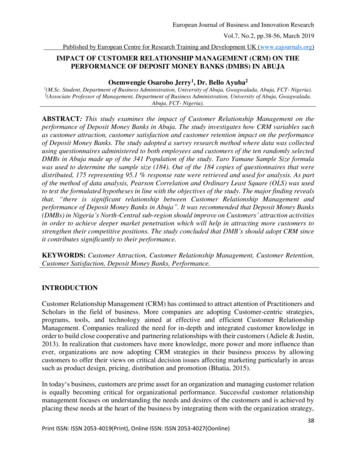

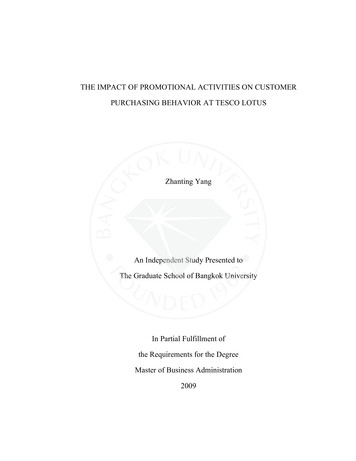
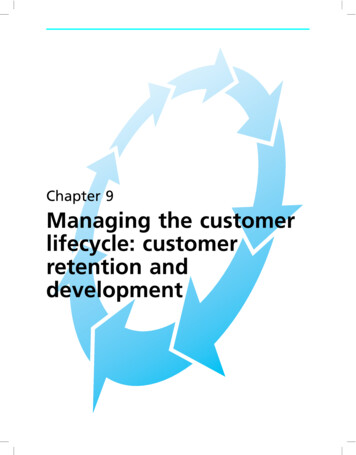
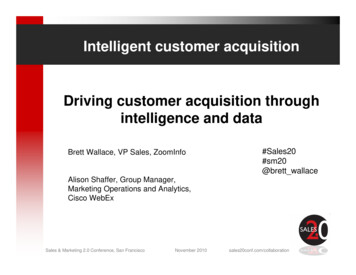
![Fluent Python : [clear, concise, and effective programming]](/img/1/799981060.jpg)
